Role of Leaders in Facilitating Change Process
VerifiedAdded on 2023/03/30
|14
|3444
|130
AI Summary
This essay discusses the role of leaders in facilitating a change process in organizations. It explores the importance of leaders in managing change, addressing resistance, and implementing successful change initiatives.
Contribute Materials
Your contribution can guide someone’s learning journey. Share your
documents today.
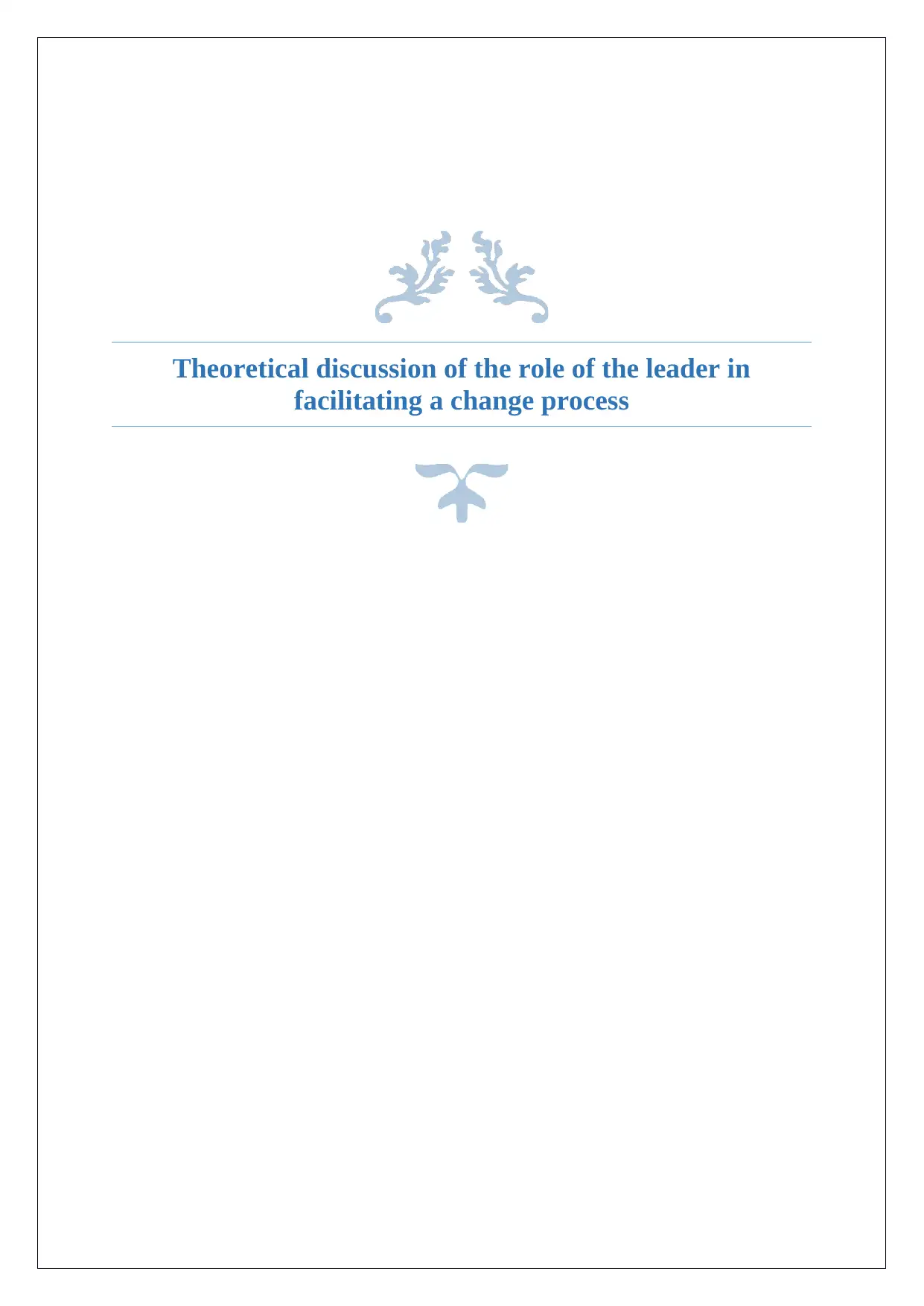
Theoretical discussion of the role of the leader in
facilitating a change process
facilitating a change process
Secure Best Marks with AI Grader
Need help grading? Try our AI Grader for instant feedback on your assignments.

Running Head: Essay
The phenomenon of globalisation and the advancement in technology has forced all the
sectors and organisations to adapt and grow. This has also resulted in mounting up of
pressure on the organisations to change in order to sustain and maintain their competitive
advantage in the industry. As humans, we have the inherent tendency to oppose change and
any change comes with debilitating fear and provokes anxiety. This essay is compiled to
carry out a discussion and explain the role played by the leaders in effective change
management in the organisations.
The disturbance in the status quo is defined as change. Change requires the individuals and
organisations to shift from one state to the other making transformation necessary. The
people leaving the organisation play a key role in facilitating change and ensuring that the
change is successfully and sustainability adopted and embraced throughout the organisation.
The leaders of the organisation have the responsibility of carrying out the operations and
directing the rest of the workforce towards success. It is their responsibility to state the right
objective and goals so that the entire organisation can collectively achieve the strategic
objectives and aims defined by the decision makers. The leaders also play an essential role in
managing change in the establishment as the influence and shape the values, beliefs and style
of the people inside and outside the organisation (Gittins & Standish, 2010).
This essay outlines the details related to the pressure and the need for change in the
organisation. There are numerous theories present in the existing academic literature
explaining the process of planning and evaluation of change in the organisation. The
discussion related to the role of a leader in the organisation when it comes to the
identification of the need for change and their collaboration with the key stakeholders for the
planning, implementation and evaluation of the performance improvement practices is also
carried out in this. There are various different types of leaders identified in an organisation
and each type has a unique approach to change management. This essay also includes a
1
The phenomenon of globalisation and the advancement in technology has forced all the
sectors and organisations to adapt and grow. This has also resulted in mounting up of
pressure on the organisations to change in order to sustain and maintain their competitive
advantage in the industry. As humans, we have the inherent tendency to oppose change and
any change comes with debilitating fear and provokes anxiety. This essay is compiled to
carry out a discussion and explain the role played by the leaders in effective change
management in the organisations.
The disturbance in the status quo is defined as change. Change requires the individuals and
organisations to shift from one state to the other making transformation necessary. The
people leaving the organisation play a key role in facilitating change and ensuring that the
change is successfully and sustainability adopted and embraced throughout the organisation.
The leaders of the organisation have the responsibility of carrying out the operations and
directing the rest of the workforce towards success. It is their responsibility to state the right
objective and goals so that the entire organisation can collectively achieve the strategic
objectives and aims defined by the decision makers. The leaders also play an essential role in
managing change in the establishment as the influence and shape the values, beliefs and style
of the people inside and outside the organisation (Gittins & Standish, 2010).
This essay outlines the details related to the pressure and the need for change in the
organisation. There are numerous theories present in the existing academic literature
explaining the process of planning and evaluation of change in the organisation. The
discussion related to the role of a leader in the organisation when it comes to the
identification of the need for change and their collaboration with the key stakeholders for the
planning, implementation and evaluation of the performance improvement practices is also
carried out in this. There are various different types of leaders identified in an organisation
and each type has a unique approach to change management. This essay also includes a
1
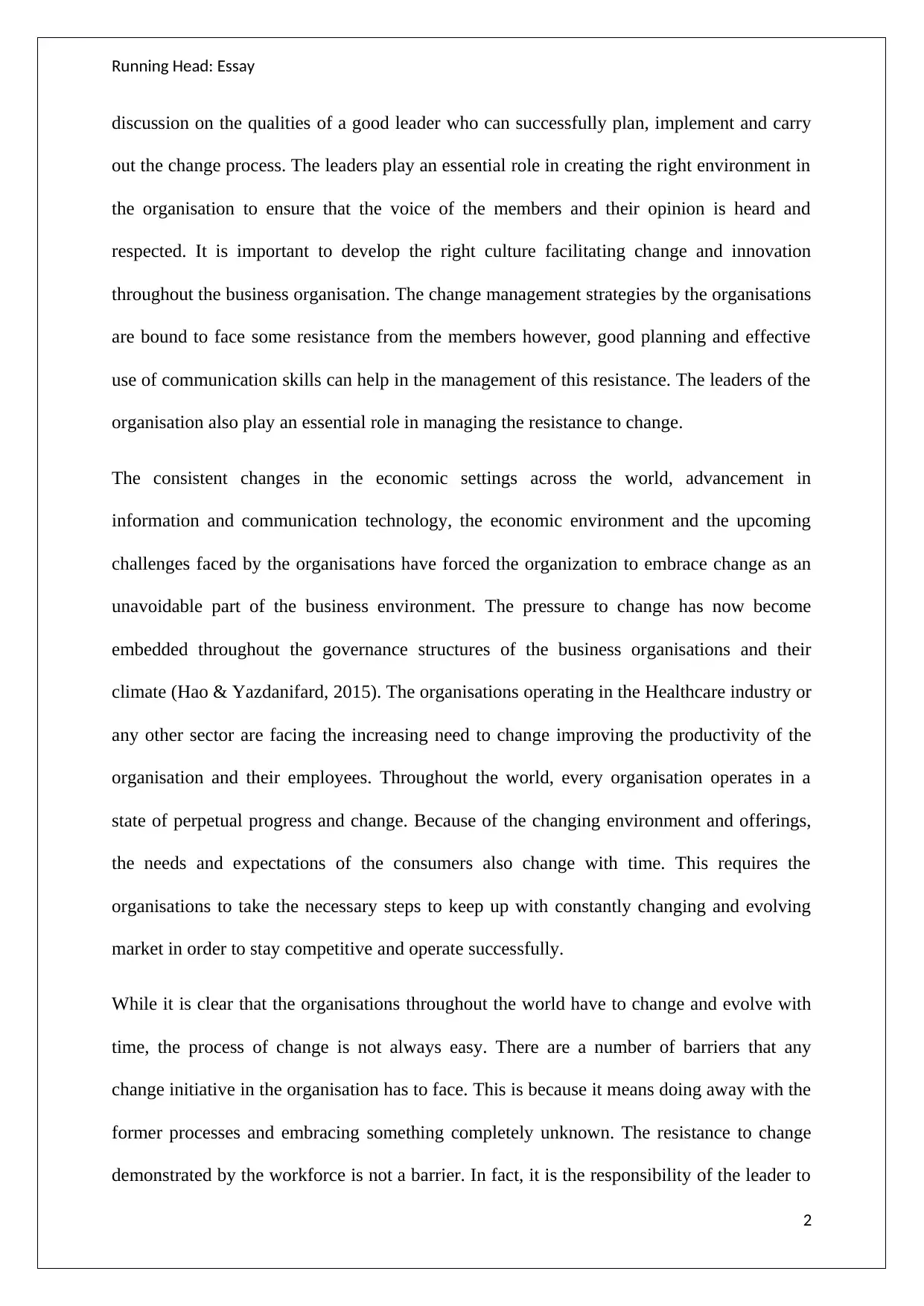
Running Head: Essay
discussion on the qualities of a good leader who can successfully plan, implement and carry
out the change process. The leaders play an essential role in creating the right environment in
the organisation to ensure that the voice of the members and their opinion is heard and
respected. It is important to develop the right culture facilitating change and innovation
throughout the business organisation. The change management strategies by the organisations
are bound to face some resistance from the members however, good planning and effective
use of communication skills can help in the management of this resistance. The leaders of the
organisation also play an essential role in managing the resistance to change.
The consistent changes in the economic settings across the world, advancement in
information and communication technology, the economic environment and the upcoming
challenges faced by the organisations have forced the organization to embrace change as an
unavoidable part of the business environment. The pressure to change has now become
embedded throughout the governance structures of the business organisations and their
climate (Hao & Yazdanifard, 2015). The organisations operating in the Healthcare industry or
any other sector are facing the increasing need to change improving the productivity of the
organisation and their employees. Throughout the world, every organisation operates in a
state of perpetual progress and change. Because of the changing environment and offerings,
the needs and expectations of the consumers also change with time. This requires the
organisations to take the necessary steps to keep up with constantly changing and evolving
market in order to stay competitive and operate successfully.
While it is clear that the organisations throughout the world have to change and evolve with
time, the process of change is not always easy. There are a number of barriers that any
change initiative in the organisation has to face. This is because it means doing away with the
former processes and embracing something completely unknown. The resistance to change
demonstrated by the workforce is not a barrier. In fact, it is the responsibility of the leader to
2
discussion on the qualities of a good leader who can successfully plan, implement and carry
out the change process. The leaders play an essential role in creating the right environment in
the organisation to ensure that the voice of the members and their opinion is heard and
respected. It is important to develop the right culture facilitating change and innovation
throughout the business organisation. The change management strategies by the organisations
are bound to face some resistance from the members however, good planning and effective
use of communication skills can help in the management of this resistance. The leaders of the
organisation also play an essential role in managing the resistance to change.
The consistent changes in the economic settings across the world, advancement in
information and communication technology, the economic environment and the upcoming
challenges faced by the organisations have forced the organization to embrace change as an
unavoidable part of the business environment. The pressure to change has now become
embedded throughout the governance structures of the business organisations and their
climate (Hao & Yazdanifard, 2015). The organisations operating in the Healthcare industry or
any other sector are facing the increasing need to change improving the productivity of the
organisation and their employees. Throughout the world, every organisation operates in a
state of perpetual progress and change. Because of the changing environment and offerings,
the needs and expectations of the consumers also change with time. This requires the
organisations to take the necessary steps to keep up with constantly changing and evolving
market in order to stay competitive and operate successfully.
While it is clear that the organisations throughout the world have to change and evolve with
time, the process of change is not always easy. There are a number of barriers that any
change initiative in the organisation has to face. This is because it means doing away with the
former processes and embracing something completely unknown. The resistance to change
demonstrated by the workforce is not a barrier. In fact, it is the responsibility of the leader to
2
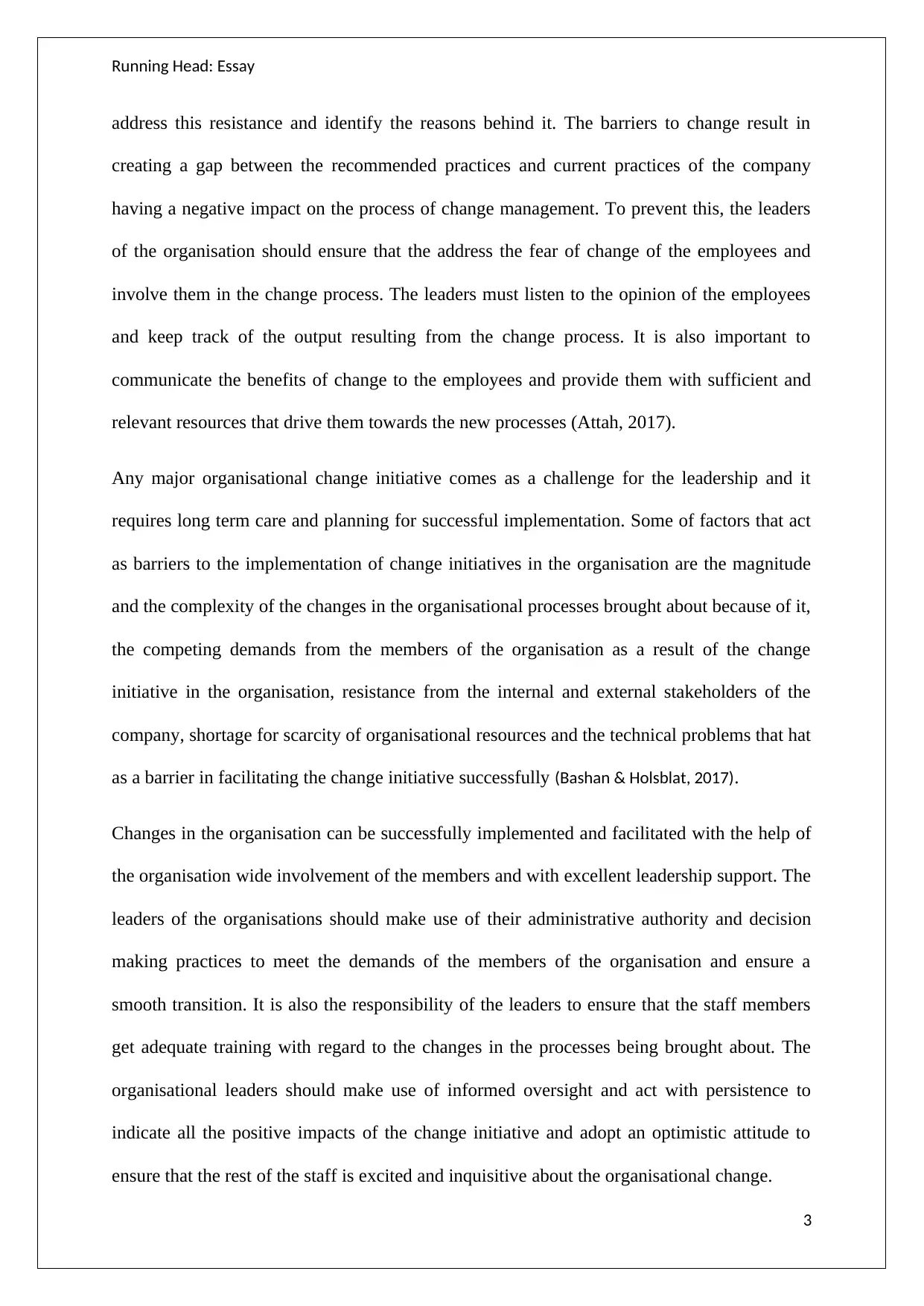
Running Head: Essay
address this resistance and identify the reasons behind it. The barriers to change result in
creating a gap between the recommended practices and current practices of the company
having a negative impact on the process of change management. To prevent this, the leaders
of the organisation should ensure that the address the fear of change of the employees and
involve them in the change process. The leaders must listen to the opinion of the employees
and keep track of the output resulting from the change process. It is also important to
communicate the benefits of change to the employees and provide them with sufficient and
relevant resources that drive them towards the new processes (Attah, 2017).
Any major organisational change initiative comes as a challenge for the leadership and it
requires long term care and planning for successful implementation. Some of factors that act
as barriers to the implementation of change initiatives in the organisation are the magnitude
and the complexity of the changes in the organisational processes brought about because of it,
the competing demands from the members of the organisation as a result of the change
initiative in the organisation, resistance from the internal and external stakeholders of the
company, shortage for scarcity of organisational resources and the technical problems that hat
as a barrier in facilitating the change initiative successfully (Bashan & Holsblat, 2017).
Changes in the organisation can be successfully implemented and facilitated with the help of
the organisation wide involvement of the members and with excellent leadership support. The
leaders of the organisations should make use of their administrative authority and decision
making practices to meet the demands of the members of the organisation and ensure a
smooth transition. It is also the responsibility of the leaders to ensure that the staff members
get adequate training with regard to the changes in the processes being brought about. The
organisational leaders should make use of informed oversight and act with persistence to
indicate all the positive impacts of the change initiative and adopt an optimistic attitude to
ensure that the rest of the staff is excited and inquisitive about the organisational change.
3
address this resistance and identify the reasons behind it. The barriers to change result in
creating a gap between the recommended practices and current practices of the company
having a negative impact on the process of change management. To prevent this, the leaders
of the organisation should ensure that the address the fear of change of the employees and
involve them in the change process. The leaders must listen to the opinion of the employees
and keep track of the output resulting from the change process. It is also important to
communicate the benefits of change to the employees and provide them with sufficient and
relevant resources that drive them towards the new processes (Attah, 2017).
Any major organisational change initiative comes as a challenge for the leadership and it
requires long term care and planning for successful implementation. Some of factors that act
as barriers to the implementation of change initiatives in the organisation are the magnitude
and the complexity of the changes in the organisational processes brought about because of it,
the competing demands from the members of the organisation as a result of the change
initiative in the organisation, resistance from the internal and external stakeholders of the
company, shortage for scarcity of organisational resources and the technical problems that hat
as a barrier in facilitating the change initiative successfully (Bashan & Holsblat, 2017).
Changes in the organisation can be successfully implemented and facilitated with the help of
the organisation wide involvement of the members and with excellent leadership support. The
leaders of the organisations should make use of their administrative authority and decision
making practices to meet the demands of the members of the organisation and ensure a
smooth transition. It is also the responsibility of the leaders to ensure that the staff members
get adequate training with regard to the changes in the processes being brought about. The
organisational leaders should make use of informed oversight and act with persistence to
indicate all the positive impacts of the change initiative and adopt an optimistic attitude to
ensure that the rest of the staff is excited and inquisitive about the organisational change.
3
Secure Best Marks with AI Grader
Need help grading? Try our AI Grader for instant feedback on your assignments.

Running Head: Essay
Kurt Lewin has provided a change model that involves three steps of unfreezing, change and
refreezing (Hussain, Akram, & Haider, 2016).
This model highlights the significance of the change in the organisations in the continuously
growing industries having very high competition among the organisations. The three stages
of change identified by Lewin allowed the organisational leaders to have better control over
the change process that runs as a common thread among all the business organisations and
sectors. Most of the organisations and organisational leaders are familiar with the concept of
change management but it is important to understand that the members involved in the
change process should have the understanding of the changes and the processes followed for
it. The first step of change according to this model involves preparing the employees and the
organisation to be more accepting of the change process. This is done by breaking down the
status quo and it is important that this process is followed for building new processes and
procedures as a result of the change. The most compelling message running throughout the
organisation by following the steps is that the leaders are able to start at the core of the
4
Kurt Lewin has provided a change model that involves three steps of unfreezing, change and
refreezing (Hussain, Akram, & Haider, 2016).
This model highlights the significance of the change in the organisations in the continuously
growing industries having very high competition among the organisations. The three stages
of change identified by Lewin allowed the organisational leaders to have better control over
the change process that runs as a common thread among all the business organisations and
sectors. Most of the organisations and organisational leaders are familiar with the concept of
change management but it is important to understand that the members involved in the
change process should have the understanding of the changes and the processes followed for
it. The first step of change according to this model involves preparing the employees and the
organisation to be more accepting of the change process. This is done by breaking down the
status quo and it is important that this process is followed for building new processes and
procedures as a result of the change. The most compelling message running throughout the
organisation by following the steps is that the leaders are able to start at the core of the
4

Running Head: Essay
business organisation and challenge the currently existing attitudes, belief, behaviour and
values of the employees (Courtney, 2011). This is generally the most stressful and
challenging part of the change process as it requires the leaders to cut down on the current
practices and involves putting the things off balance in the organisation.
This is followed by the second stage of the change process. The organisational leaders have
developed uncertainty in the unfreezing stage. Now it is time to take the steps for the
resolution of this uncertainty and provide the support to the workforce to move towards the
new direction. It is important that the leaders understand that the change process takes time
and they cannot expect an overnight transformation of the behaviour and practices. This is
also the time when the organisational leaders face resistance because not all members of the
organisation believe that changes are necessary and that the changes in the processes being
brought about will be beneficial for them. It is important to avoid this pitfall by addressing
the resistance to change effectively and establishing proper communication channels for
resolving any doubts and queries. The two most essential factors for successful change
management across the organisation are communication and time. The leaders should give
the members of the organisation the necessary time to understand the need and significance
of change and ensure that they feel connected and involved throughout the period of
transition (Antwi & Kale, 2014).
The third and the final step mentioned in the Change management model by Lewin is the
refreezing of the change. Once the organisation has successfully embraced the change
brought about by the management, it is the responsibility of the leader to ensure that they
refreeze and bring about a sense of stability in the organisation to reinstate the feelings of
comfort and confidence among the employees. If the leaders are unable to do this, the
employees often get caught in the trap of constant transition and ambiguity making it
impossible for the leaders to carry out another change initiative. Refreezing is done by the
5
business organisation and challenge the currently existing attitudes, belief, behaviour and
values of the employees (Courtney, 2011). This is generally the most stressful and
challenging part of the change process as it requires the leaders to cut down on the current
practices and involves putting the things off balance in the organisation.
This is followed by the second stage of the change process. The organisational leaders have
developed uncertainty in the unfreezing stage. Now it is time to take the steps for the
resolution of this uncertainty and provide the support to the workforce to move towards the
new direction. It is important that the leaders understand that the change process takes time
and they cannot expect an overnight transformation of the behaviour and practices. This is
also the time when the organisational leaders face resistance because not all members of the
organisation believe that changes are necessary and that the changes in the processes being
brought about will be beneficial for them. It is important to avoid this pitfall by addressing
the resistance to change effectively and establishing proper communication channels for
resolving any doubts and queries. The two most essential factors for successful change
management across the organisation are communication and time. The leaders should give
the members of the organisation the necessary time to understand the need and significance
of change and ensure that they feel connected and involved throughout the period of
transition (Antwi & Kale, 2014).
The third and the final step mentioned in the Change management model by Lewin is the
refreezing of the change. Once the organisation has successfully embraced the change
brought about by the management, it is the responsibility of the leader to ensure that they
refreeze and bring about a sense of stability in the organisation to reinstate the feelings of
comfort and confidence among the employees. If the leaders are unable to do this, the
employees often get caught in the trap of constant transition and ambiguity making it
impossible for the leaders to carry out another change initiative. Refreezing is done by the
5
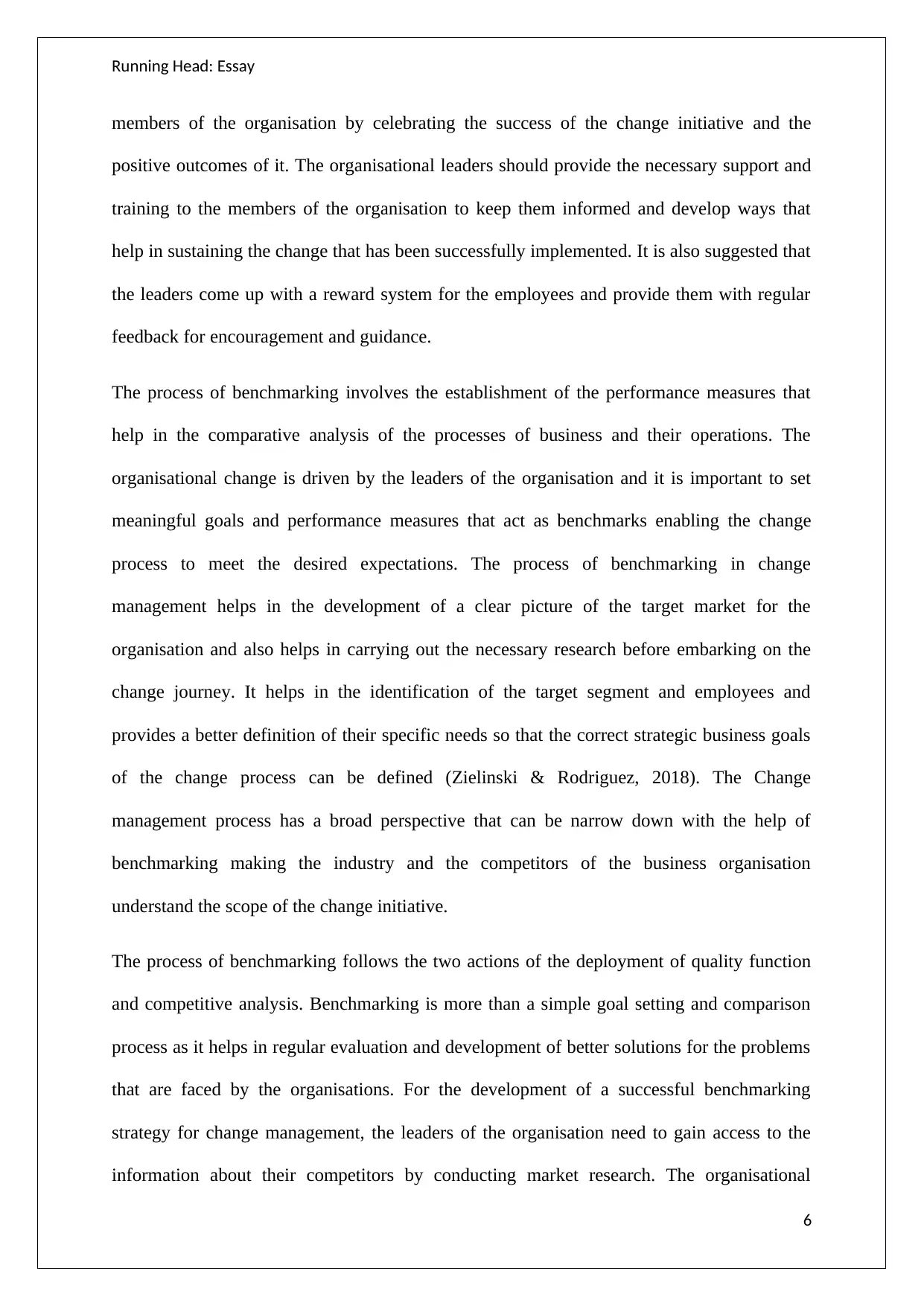
Running Head: Essay
members of the organisation by celebrating the success of the change initiative and the
positive outcomes of it. The organisational leaders should provide the necessary support and
training to the members of the organisation to keep them informed and develop ways that
help in sustaining the change that has been successfully implemented. It is also suggested that
the leaders come up with a reward system for the employees and provide them with regular
feedback for encouragement and guidance.
The process of benchmarking involves the establishment of the performance measures that
help in the comparative analysis of the processes of business and their operations. The
organisational change is driven by the leaders of the organisation and it is important to set
meaningful goals and performance measures that act as benchmarks enabling the change
process to meet the desired expectations. The process of benchmarking in change
management helps in the development of a clear picture of the target market for the
organisation and also helps in carrying out the necessary research before embarking on the
change journey. It helps in the identification of the target segment and employees and
provides a better definition of their specific needs so that the correct strategic business goals
of the change process can be defined (Zielinski & Rodriguez, 2018). The Change
management process has a broad perspective that can be narrow down with the help of
benchmarking making the industry and the competitors of the business organisation
understand the scope of the change initiative.
The process of benchmarking follows the two actions of the deployment of quality function
and competitive analysis. Benchmarking is more than a simple goal setting and comparison
process as it helps in regular evaluation and development of better solutions for the problems
that are faced by the organisations. For the development of a successful benchmarking
strategy for change management, the leaders of the organisation need to gain access to the
information about their competitors by conducting market research. The organisational
6
members of the organisation by celebrating the success of the change initiative and the
positive outcomes of it. The organisational leaders should provide the necessary support and
training to the members of the organisation to keep them informed and develop ways that
help in sustaining the change that has been successfully implemented. It is also suggested that
the leaders come up with a reward system for the employees and provide them with regular
feedback for encouragement and guidance.
The process of benchmarking involves the establishment of the performance measures that
help in the comparative analysis of the processes of business and their operations. The
organisational change is driven by the leaders of the organisation and it is important to set
meaningful goals and performance measures that act as benchmarks enabling the change
process to meet the desired expectations. The process of benchmarking in change
management helps in the development of a clear picture of the target market for the
organisation and also helps in carrying out the necessary research before embarking on the
change journey. It helps in the identification of the target segment and employees and
provides a better definition of their specific needs so that the correct strategic business goals
of the change process can be defined (Zielinski & Rodriguez, 2018). The Change
management process has a broad perspective that can be narrow down with the help of
benchmarking making the industry and the competitors of the business organisation
understand the scope of the change initiative.
The process of benchmarking follows the two actions of the deployment of quality function
and competitive analysis. Benchmarking is more than a simple goal setting and comparison
process as it helps in regular evaluation and development of better solutions for the problems
that are faced by the organisations. For the development of a successful benchmarking
strategy for change management, the leaders of the organisation need to gain access to the
information about their competitors by conducting market research. The organisational
6
Paraphrase This Document
Need a fresh take? Get an instant paraphrase of this document with our AI Paraphraser
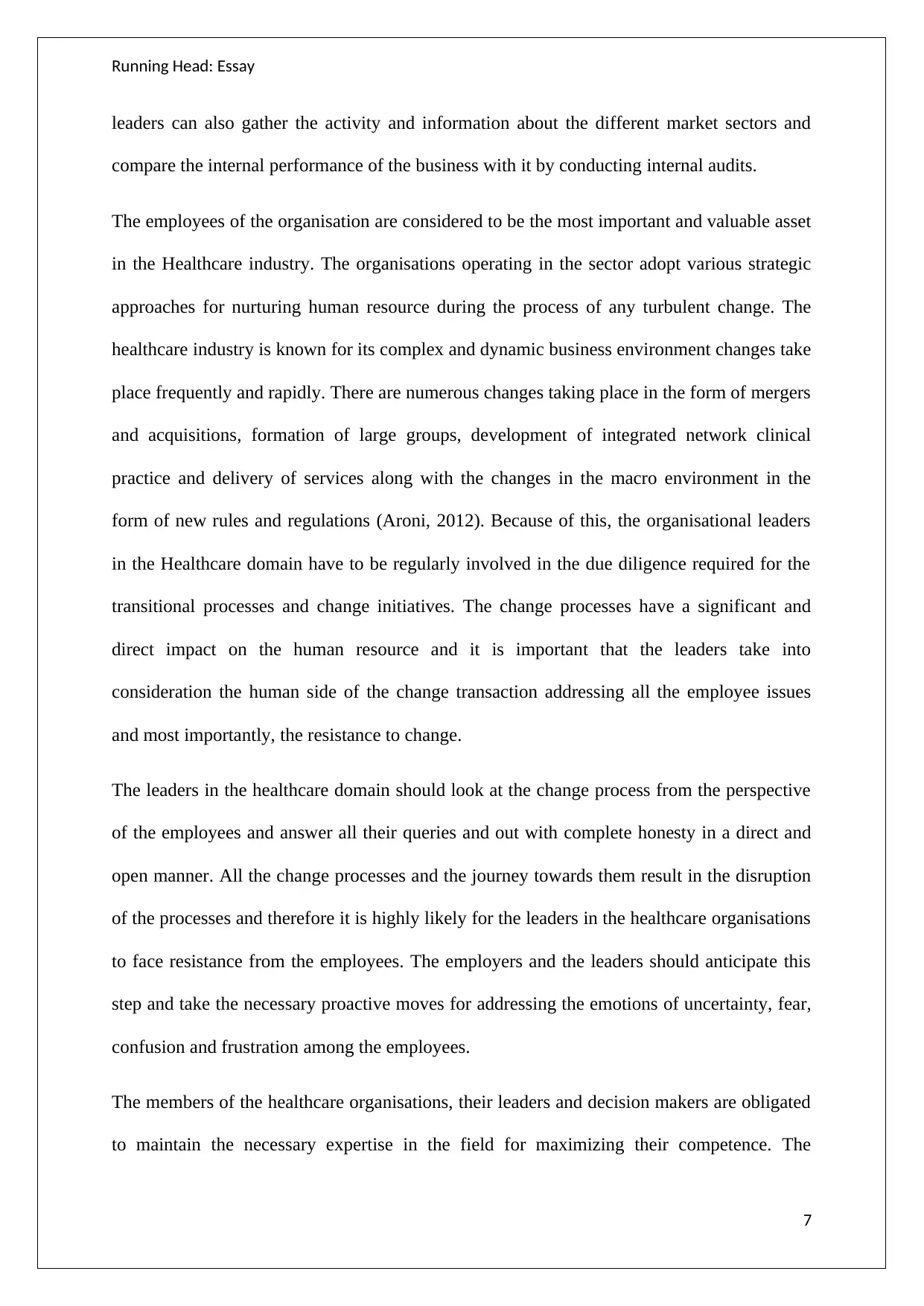
Running Head: Essay
leaders can also gather the activity and information about the different market sectors and
compare the internal performance of the business with it by conducting internal audits.
The employees of the organisation are considered to be the most important and valuable asset
in the Healthcare industry. The organisations operating in the sector adopt various strategic
approaches for nurturing human resource during the process of any turbulent change. The
healthcare industry is known for its complex and dynamic business environment changes take
place frequently and rapidly. There are numerous changes taking place in the form of mergers
and acquisitions, formation of large groups, development of integrated network clinical
practice and delivery of services along with the changes in the macro environment in the
form of new rules and regulations (Aroni, 2012). Because of this, the organisational leaders
in the Healthcare domain have to be regularly involved in the due diligence required for the
transitional processes and change initiatives. The change processes have a significant and
direct impact on the human resource and it is important that the leaders take into
consideration the human side of the change transaction addressing all the employee issues
and most importantly, the resistance to change.
The leaders in the healthcare domain should look at the change process from the perspective
of the employees and answer all their queries and out with complete honesty in a direct and
open manner. All the change processes and the journey towards them result in the disruption
of the processes and therefore it is highly likely for the leaders in the healthcare organisations
to face resistance from the employees. The employers and the leaders should anticipate this
step and take the necessary proactive moves for addressing the emotions of uncertainty, fear,
confusion and frustration among the employees.
The members of the healthcare organisations, their leaders and decision makers are obligated
to maintain the necessary expertise in the field for maximizing their competence. The
7
leaders can also gather the activity and information about the different market sectors and
compare the internal performance of the business with it by conducting internal audits.
The employees of the organisation are considered to be the most important and valuable asset
in the Healthcare industry. The organisations operating in the sector adopt various strategic
approaches for nurturing human resource during the process of any turbulent change. The
healthcare industry is known for its complex and dynamic business environment changes take
place frequently and rapidly. There are numerous changes taking place in the form of mergers
and acquisitions, formation of large groups, development of integrated network clinical
practice and delivery of services along with the changes in the macro environment in the
form of new rules and regulations (Aroni, 2012). Because of this, the organisational leaders
in the Healthcare domain have to be regularly involved in the due diligence required for the
transitional processes and change initiatives. The change processes have a significant and
direct impact on the human resource and it is important that the leaders take into
consideration the human side of the change transaction addressing all the employee issues
and most importantly, the resistance to change.
The leaders in the healthcare domain should look at the change process from the perspective
of the employees and answer all their queries and out with complete honesty in a direct and
open manner. All the change processes and the journey towards them result in the disruption
of the processes and therefore it is highly likely for the leaders in the healthcare organisations
to face resistance from the employees. The employers and the leaders should anticipate this
step and take the necessary proactive moves for addressing the emotions of uncertainty, fear,
confusion and frustration among the employees.
The members of the healthcare organisations, their leaders and decision makers are obligated
to maintain the necessary expertise in the field for maximizing their competence. The
7
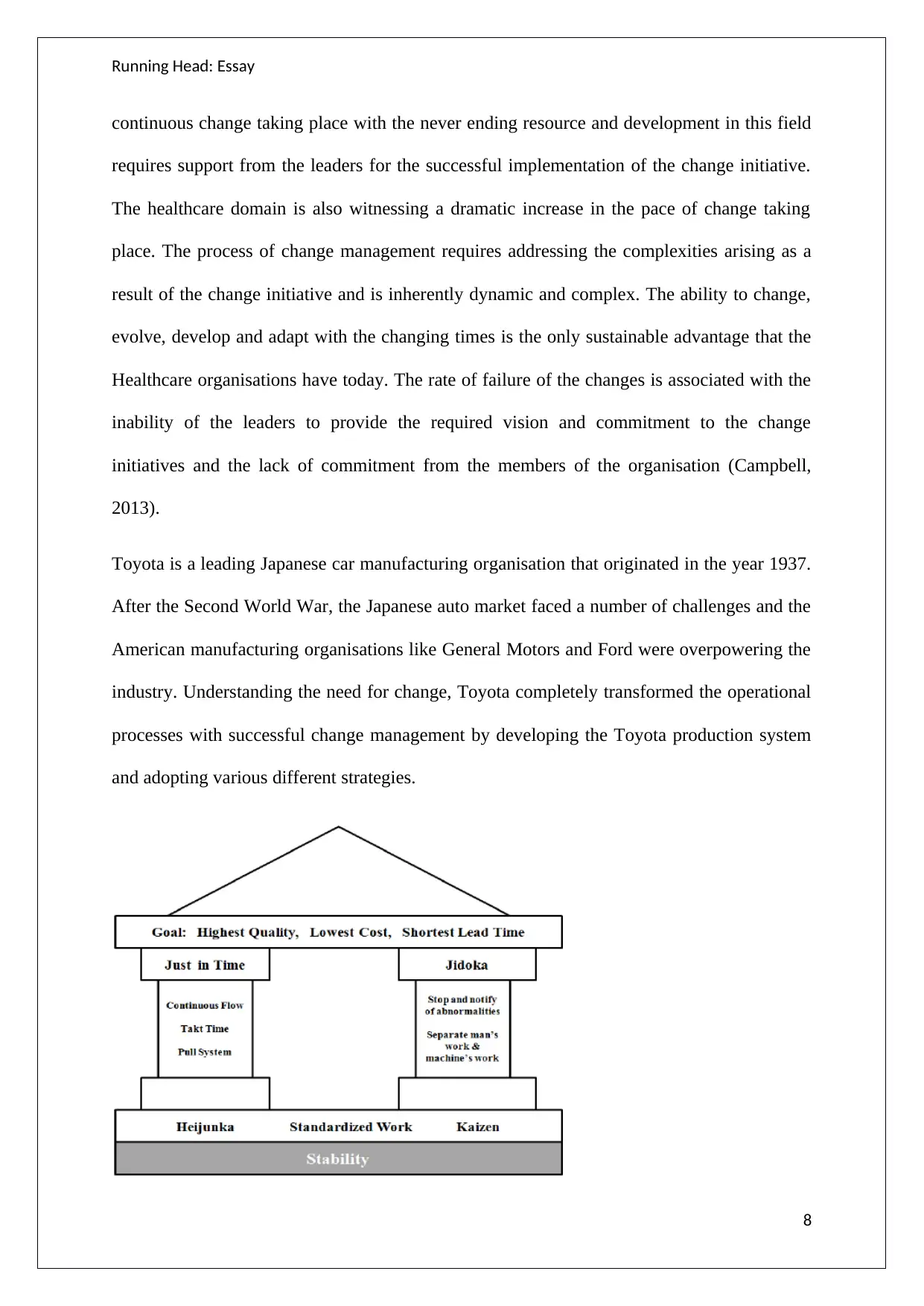
Running Head: Essay
continuous change taking place with the never ending resource and development in this field
requires support from the leaders for the successful implementation of the change initiative.
The healthcare domain is also witnessing a dramatic increase in the pace of change taking
place. The process of change management requires addressing the complexities arising as a
result of the change initiative and is inherently dynamic and complex. The ability to change,
evolve, develop and adapt with the changing times is the only sustainable advantage that the
Healthcare organisations have today. The rate of failure of the changes is associated with the
inability of the leaders to provide the required vision and commitment to the change
initiatives and the lack of commitment from the members of the organisation (Campbell,
2013).
Toyota is a leading Japanese car manufacturing organisation that originated in the year 1937.
After the Second World War, the Japanese auto market faced a number of challenges and the
American manufacturing organisations like General Motors and Ford were overpowering the
industry. Understanding the need for change, Toyota completely transformed the operational
processes with successful change management by developing the Toyota production system
and adopting various different strategies.
8
continuous change taking place with the never ending resource and development in this field
requires support from the leaders for the successful implementation of the change initiative.
The healthcare domain is also witnessing a dramatic increase in the pace of change taking
place. The process of change management requires addressing the complexities arising as a
result of the change initiative and is inherently dynamic and complex. The ability to change,
evolve, develop and adapt with the changing times is the only sustainable advantage that the
Healthcare organisations have today. The rate of failure of the changes is associated with the
inability of the leaders to provide the required vision and commitment to the change
initiatives and the lack of commitment from the members of the organisation (Campbell,
2013).
Toyota is a leading Japanese car manufacturing organisation that originated in the year 1937.
After the Second World War, the Japanese auto market faced a number of challenges and the
American manufacturing organisations like General Motors and Ford were overpowering the
industry. Understanding the need for change, Toyota completely transformed the operational
processes with successful change management by developing the Toyota production system
and adopting various different strategies.
8

Running Head: Essay
The leaders of the organisation created continuous process flow and standardized the tasks to
enable employee empowerment throughout the company. The case of Toyota Motor
Corporation is considered to be one of the best examples of effective change management
(Chen, Kao , & Wang , 2018).
Everyone is familiar with the e-commerce Amazon that is led by Jeff Bezos for more than
two decades now. The Seattle-based organisation launched its website in the year 1995 and is
the epitome of continuous and effective change management. Amazon first launched its
website for selling books and gradually diversified to include CDs and DVDs. The
organisation has never stopped changing since its inception and it currently has more than
200 million products catering to the different needs of the customers throughout the world
(Azmeh, 2016).
The culture of the organisation is a reflection of what the members of the organisation value.
It also demonstrates the dominant style of leadership and management practice by I the
seniors and how the organisation define success. All these factors together constitute the
culture of the organisation. The leadership, managers and executives of the company set the
structures that determine the trajectory to be followed by the organisation. This tragic tree is
defined as the direction taken by the company at any given point. It is the responsibility of the
leaders to influence the individuals within the organisation and enable them to observe the
change initiative, innovation for the newly established structure by practising effective
leadership. It is important that all the members of the organisation are moving in a similar
direction and following similar procedures and duties. But the leaders also need to allow
freedom and flexibility to provide the members with the ability to adapt to the changes and
react to any external stimuli. This demands for a structural balance from the end of the
leaders. The organisational change forms the basis for capacity building in the healthcare
domain (Kumah, Ankomah, & Antwi, 2016).
9
The leaders of the organisation created continuous process flow and standardized the tasks to
enable employee empowerment throughout the company. The case of Toyota Motor
Corporation is considered to be one of the best examples of effective change management
(Chen, Kao , & Wang , 2018).
Everyone is familiar with the e-commerce Amazon that is led by Jeff Bezos for more than
two decades now. The Seattle-based organisation launched its website in the year 1995 and is
the epitome of continuous and effective change management. Amazon first launched its
website for selling books and gradually diversified to include CDs and DVDs. The
organisation has never stopped changing since its inception and it currently has more than
200 million products catering to the different needs of the customers throughout the world
(Azmeh, 2016).
The culture of the organisation is a reflection of what the members of the organisation value.
It also demonstrates the dominant style of leadership and management practice by I the
seniors and how the organisation define success. All these factors together constitute the
culture of the organisation. The leadership, managers and executives of the company set the
structures that determine the trajectory to be followed by the organisation. This tragic tree is
defined as the direction taken by the company at any given point. It is the responsibility of the
leaders to influence the individuals within the organisation and enable them to observe the
change initiative, innovation for the newly established structure by practising effective
leadership. It is important that all the members of the organisation are moving in a similar
direction and following similar procedures and duties. But the leaders also need to allow
freedom and flexibility to provide the members with the ability to adapt to the changes and
react to any external stimuli. This demands for a structural balance from the end of the
leaders. The organisational change forms the basis for capacity building in the healthcare
domain (Kumah, Ankomah, & Antwi, 2016).
9
Secure Best Marks with AI Grader
Need help grading? Try our AI Grader for instant feedback on your assignments.
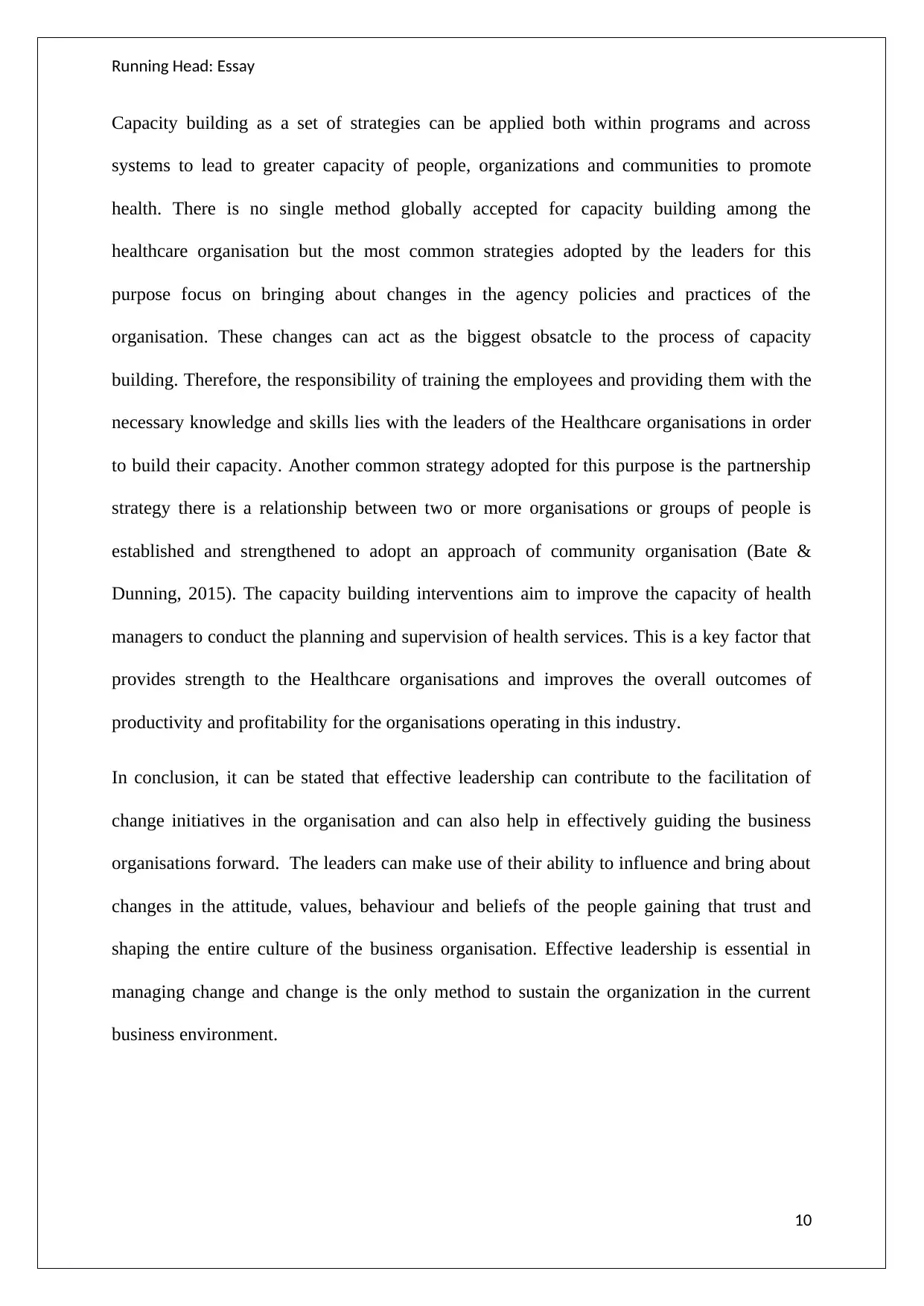
Running Head: Essay
Capacity building as a set of strategies can be applied both within programs and across
systems to lead to greater capacity of people, organizations and communities to promote
health. There is no single method globally accepted for capacity building among the
healthcare organisation but the most common strategies adopted by the leaders for this
purpose focus on bringing about changes in the agency policies and practices of the
organisation. These changes can act as the biggest obsatcle to the process of capacity
building. Therefore, the responsibility of training the employees and providing them with the
necessary knowledge and skills lies with the leaders of the Healthcare organisations in order
to build their capacity. Another common strategy adopted for this purpose is the partnership
strategy there is a relationship between two or more organisations or groups of people is
established and strengthened to adopt an approach of community organisation (Bate &
Dunning, 2015). The capacity building interventions aim to improve the capacity of health
managers to conduct the planning and supervision of health services. This is a key factor that
provides strength to the Healthcare organisations and improves the overall outcomes of
productivity and profitability for the organisations operating in this industry.
In conclusion, it can be stated that effective leadership can contribute to the facilitation of
change initiatives in the organisation and can also help in effectively guiding the business
organisations forward. The leaders can make use of their ability to influence and bring about
changes in the attitude, values, behaviour and beliefs of the people gaining that trust and
shaping the entire culture of the business organisation. Effective leadership is essential in
managing change and change is the only method to sustain the organization in the current
business environment.
10
Capacity building as a set of strategies can be applied both within programs and across
systems to lead to greater capacity of people, organizations and communities to promote
health. There is no single method globally accepted for capacity building among the
healthcare organisation but the most common strategies adopted by the leaders for this
purpose focus on bringing about changes in the agency policies and practices of the
organisation. These changes can act as the biggest obsatcle to the process of capacity
building. Therefore, the responsibility of training the employees and providing them with the
necessary knowledge and skills lies with the leaders of the Healthcare organisations in order
to build their capacity. Another common strategy adopted for this purpose is the partnership
strategy there is a relationship between two or more organisations or groups of people is
established and strengthened to adopt an approach of community organisation (Bate &
Dunning, 2015). The capacity building interventions aim to improve the capacity of health
managers to conduct the planning and supervision of health services. This is a key factor that
provides strength to the Healthcare organisations and improves the overall outcomes of
productivity and profitability for the organisations operating in this industry.
In conclusion, it can be stated that effective leadership can contribute to the facilitation of
change initiatives in the organisation and can also help in effectively guiding the business
organisations forward. The leaders can make use of their ability to influence and bring about
changes in the attitude, values, behaviour and beliefs of the people gaining that trust and
shaping the entire culture of the business organisation. Effective leadership is essential in
managing change and change is the only method to sustain the organization in the current
business environment.
10
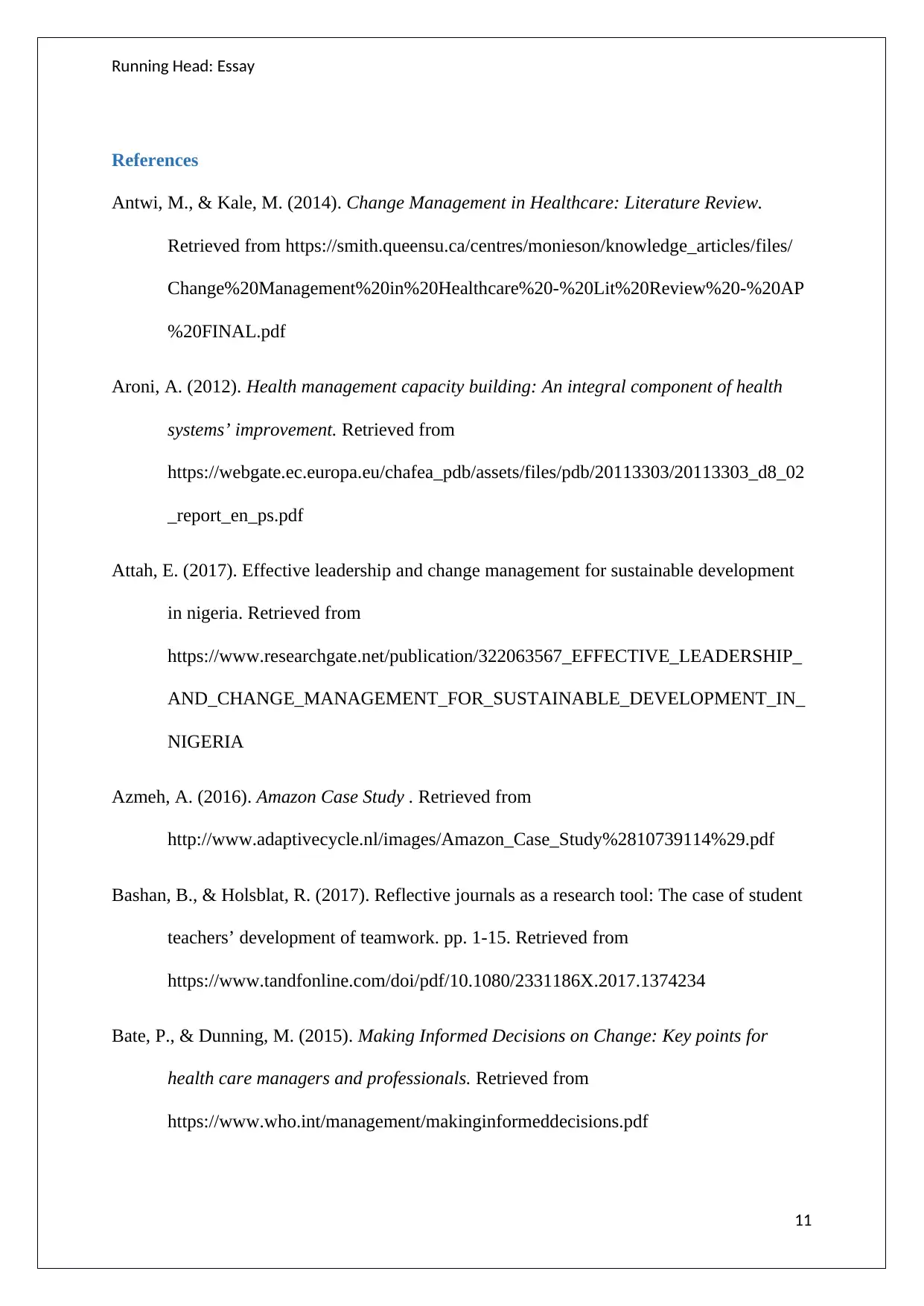
Running Head: Essay
References
Antwi, M., & Kale, M. (2014). Change Management in Healthcare: Literature Review.
Retrieved from https://smith.queensu.ca/centres/monieson/knowledge_articles/files/
Change%20Management%20in%20Healthcare%20-%20Lit%20Review%20-%20AP
%20FINAL.pdf
Aroni, A. (2012). Health management capacity building: An integral component of health
systems’ improvement. Retrieved from
https://webgate.ec.europa.eu/chafea_pdb/assets/files/pdb/20113303/20113303_d8_02
_report_en_ps.pdf
Attah, E. (2017). Effective leadership and change management for sustainable development
in nigeria. Retrieved from
https://www.researchgate.net/publication/322063567_EFFECTIVE_LEADERSHIP_
AND_CHANGE_MANAGEMENT_FOR_SUSTAINABLE_DEVELOPMENT_IN_
NIGERIA
Azmeh, A. (2016). Amazon Case Study . Retrieved from
http://www.adaptivecycle.nl/images/Amazon_Case_Study%2810739114%29.pdf
Bashan, B., & Holsblat, R. (2017). Reflective journals as a research tool: The case of student
teachers’ development of teamwork. pp. 1-15. Retrieved from
https://www.tandfonline.com/doi/pdf/10.1080/2331186X.2017.1374234
Bate, P., & Dunning, M. (2015). Making Informed Decisions on Change: Key points for
health care managers and professionals. Retrieved from
https://www.who.int/management/makinginformeddecisions.pdf
11
References
Antwi, M., & Kale, M. (2014). Change Management in Healthcare: Literature Review.
Retrieved from https://smith.queensu.ca/centres/monieson/knowledge_articles/files/
Change%20Management%20in%20Healthcare%20-%20Lit%20Review%20-%20AP
%20FINAL.pdf
Aroni, A. (2012). Health management capacity building: An integral component of health
systems’ improvement. Retrieved from
https://webgate.ec.europa.eu/chafea_pdb/assets/files/pdb/20113303/20113303_d8_02
_report_en_ps.pdf
Attah, E. (2017). Effective leadership and change management for sustainable development
in nigeria. Retrieved from
https://www.researchgate.net/publication/322063567_EFFECTIVE_LEADERSHIP_
AND_CHANGE_MANAGEMENT_FOR_SUSTAINABLE_DEVELOPMENT_IN_
NIGERIA
Azmeh, A. (2016). Amazon Case Study . Retrieved from
http://www.adaptivecycle.nl/images/Amazon_Case_Study%2810739114%29.pdf
Bashan, B., & Holsblat, R. (2017). Reflective journals as a research tool: The case of student
teachers’ development of teamwork. pp. 1-15. Retrieved from
https://www.tandfonline.com/doi/pdf/10.1080/2331186X.2017.1374234
Bate, P., & Dunning, M. (2015). Making Informed Decisions on Change: Key points for
health care managers and professionals. Retrieved from
https://www.who.int/management/makinginformeddecisions.pdf
11
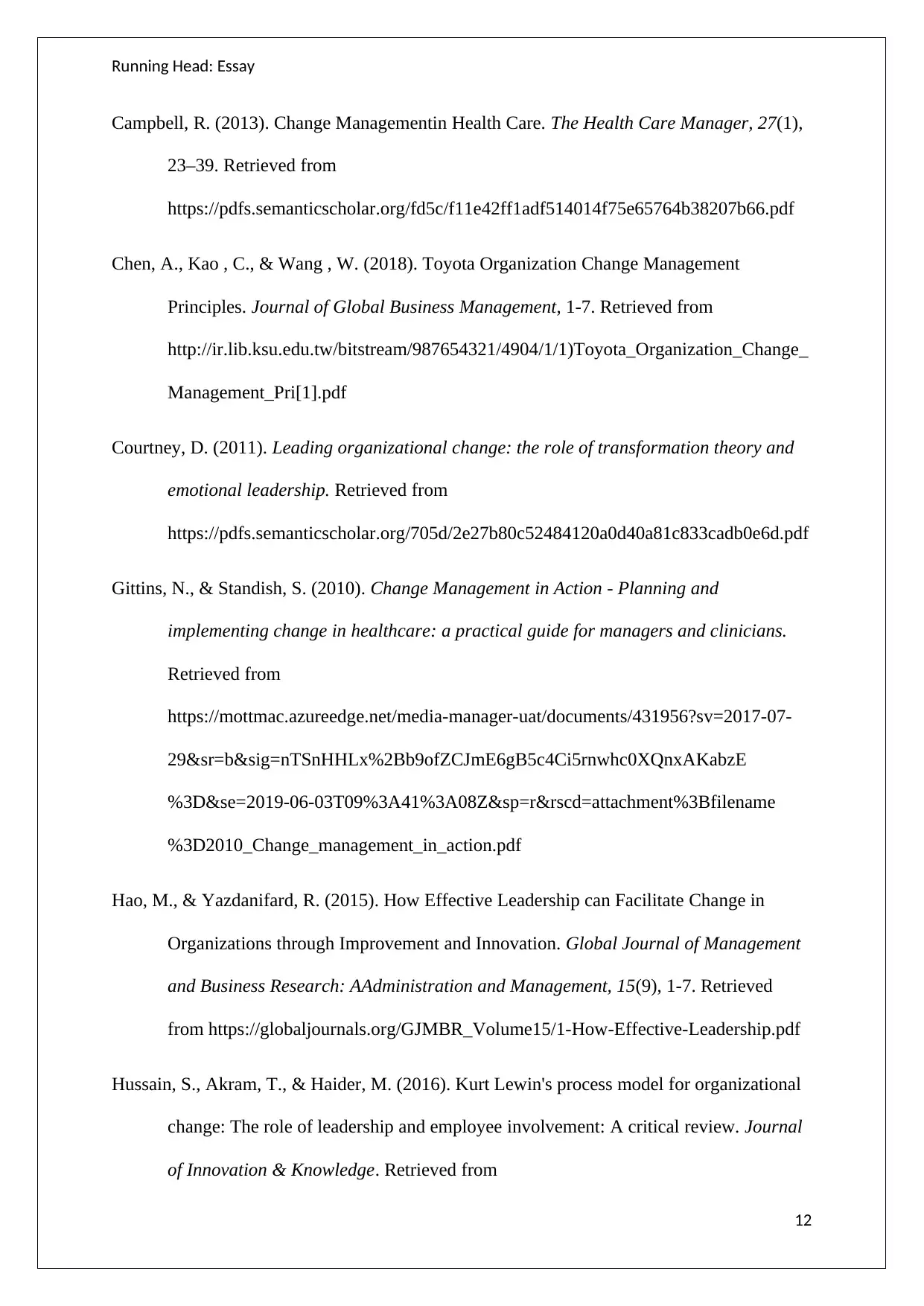
Running Head: Essay
Campbell, R. (2013). Change Managementin Health Care. The Health Care Manager, 27(1),
23–39. Retrieved from
https://pdfs.semanticscholar.org/fd5c/f11e42ff1adf514014f75e65764b38207b66.pdf
Chen, A., Kao , C., & Wang , W. (2018). Toyota Organization Change Management
Principles. Journal of Global Business Management, 1-7. Retrieved from
http://ir.lib.ksu.edu.tw/bitstream/987654321/4904/1/1)Toyota_Organization_Change_
Management_Pri[1].pdf
Courtney, D. (2011). Leading organizational change: the role of transformation theory and
emotional leadership. Retrieved from
https://pdfs.semanticscholar.org/705d/2e27b80c52484120a0d40a81c833cadb0e6d.pdf
Gittins, N., & Standish, S. (2010). Change Management in Action - Planning and
implementing change in healthcare: a practical guide for managers and clinicians.
Retrieved from
https://mottmac.azureedge.net/media-manager-uat/documents/431956?sv=2017-07-
29&sr=b&sig=nTSnHHLx%2Bb9ofZCJmE6gB5c4Ci5rnwhc0XQnxAKabzE
%3D&se=2019-06-03T09%3A41%3A08Z&sp=r&rscd=attachment%3Bfilename
%3D2010_Change_management_in_action.pdf
Hao, M., & Yazdanifard, R. (2015). How Effective Leadership can Facilitate Change in
Organizations through Improvement and Innovation. Global Journal of Management
and Business Research: AAdministration and Management, 15(9), 1-7. Retrieved
from https://globaljournals.org/GJMBR_Volume15/1-How-Effective-Leadership.pdf
Hussain, S., Akram, T., & Haider, M. (2016). Kurt Lewin's process model for organizational
change: The role of leadership and employee involvement: A critical review. Journal
of Innovation & Knowledge. Retrieved from
12
Campbell, R. (2013). Change Managementin Health Care. The Health Care Manager, 27(1),
23–39. Retrieved from
https://pdfs.semanticscholar.org/fd5c/f11e42ff1adf514014f75e65764b38207b66.pdf
Chen, A., Kao , C., & Wang , W. (2018). Toyota Organization Change Management
Principles. Journal of Global Business Management, 1-7. Retrieved from
http://ir.lib.ksu.edu.tw/bitstream/987654321/4904/1/1)Toyota_Organization_Change_
Management_Pri[1].pdf
Courtney, D. (2011). Leading organizational change: the role of transformation theory and
emotional leadership. Retrieved from
https://pdfs.semanticscholar.org/705d/2e27b80c52484120a0d40a81c833cadb0e6d.pdf
Gittins, N., & Standish, S. (2010). Change Management in Action - Planning and
implementing change in healthcare: a practical guide for managers and clinicians.
Retrieved from
https://mottmac.azureedge.net/media-manager-uat/documents/431956?sv=2017-07-
29&sr=b&sig=nTSnHHLx%2Bb9ofZCJmE6gB5c4Ci5rnwhc0XQnxAKabzE
%3D&se=2019-06-03T09%3A41%3A08Z&sp=r&rscd=attachment%3Bfilename
%3D2010_Change_management_in_action.pdf
Hao, M., & Yazdanifard, R. (2015). How Effective Leadership can Facilitate Change in
Organizations through Improvement and Innovation. Global Journal of Management
and Business Research: AAdministration and Management, 15(9), 1-7. Retrieved
from https://globaljournals.org/GJMBR_Volume15/1-How-Effective-Leadership.pdf
Hussain, S., Akram, T., & Haider, M. (2016). Kurt Lewin's process model for organizational
change: The role of leadership and employee involvement: A critical review. Journal
of Innovation & Knowledge. Retrieved from
12
Paraphrase This Document
Need a fresh take? Get an instant paraphrase of this document with our AI Paraphraser
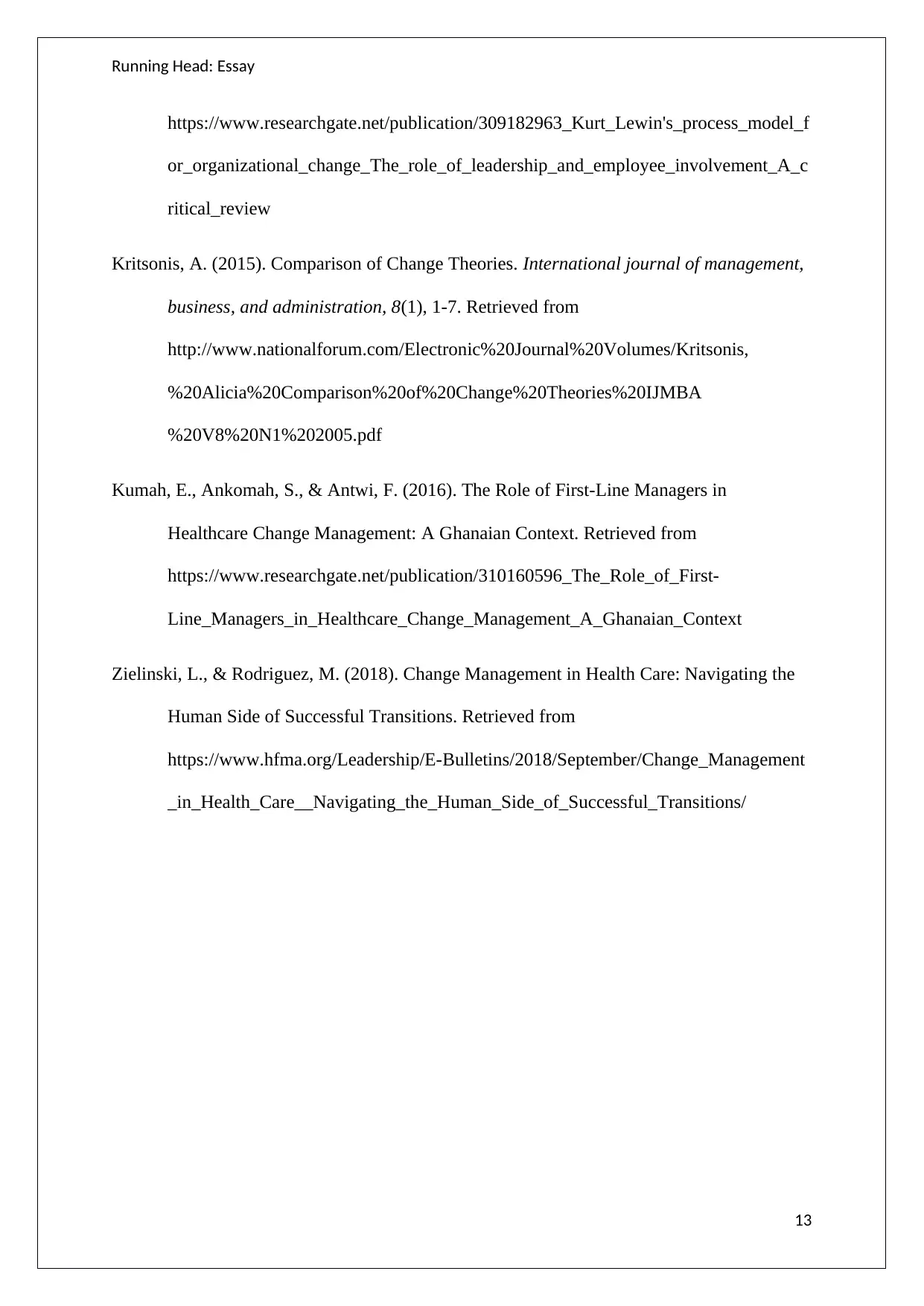
Running Head: Essay
https://www.researchgate.net/publication/309182963_Kurt_Lewin's_process_model_f
or_organizational_change_The_role_of_leadership_and_employee_involvement_A_c
ritical_review
Kritsonis, A. (2015). Comparison of Change Theories. International journal of management,
business, and administration, 8(1), 1-7. Retrieved from
http://www.nationalforum.com/Electronic%20Journal%20Volumes/Kritsonis,
%20Alicia%20Comparison%20of%20Change%20Theories%20IJMBA
%20V8%20N1%202005.pdf
Kumah, E., Ankomah, S., & Antwi, F. (2016). The Role of First-Line Managers in
Healthcare Change Management: A Ghanaian Context. Retrieved from
https://www.researchgate.net/publication/310160596_The_Role_of_First-
Line_Managers_in_Healthcare_Change_Management_A_Ghanaian_Context
Zielinski, L., & Rodriguez, M. (2018). Change Management in Health Care: Navigating the
Human Side of Successful Transitions. Retrieved from
https://www.hfma.org/Leadership/E-Bulletins/2018/September/Change_Management
_in_Health_Care__Navigating_the_Human_Side_of_Successful_Transitions/
13
https://www.researchgate.net/publication/309182963_Kurt_Lewin's_process_model_f
or_organizational_change_The_role_of_leadership_and_employee_involvement_A_c
ritical_review
Kritsonis, A. (2015). Comparison of Change Theories. International journal of management,
business, and administration, 8(1), 1-7. Retrieved from
http://www.nationalforum.com/Electronic%20Journal%20Volumes/Kritsonis,
%20Alicia%20Comparison%20of%20Change%20Theories%20IJMBA
%20V8%20N1%202005.pdf
Kumah, E., Ankomah, S., & Antwi, F. (2016). The Role of First-Line Managers in
Healthcare Change Management: A Ghanaian Context. Retrieved from
https://www.researchgate.net/publication/310160596_The_Role_of_First-
Line_Managers_in_Healthcare_Change_Management_A_Ghanaian_Context
Zielinski, L., & Rodriguez, M. (2018). Change Management in Health Care: Navigating the
Human Side of Successful Transitions. Retrieved from
https://www.hfma.org/Leadership/E-Bulletins/2018/September/Change_Management
_in_Health_Care__Navigating_the_Human_Side_of_Successful_Transitions/
13
1 out of 14
Related Documents
Your All-in-One AI-Powered Toolkit for Academic Success.
+13062052269
info@desklib.com
Available 24*7 on WhatsApp / Email
![[object Object]](/_next/static/media/star-bottom.7253800d.svg)
Unlock your academic potential
© 2024 | Zucol Services PVT LTD | All rights reserved.





